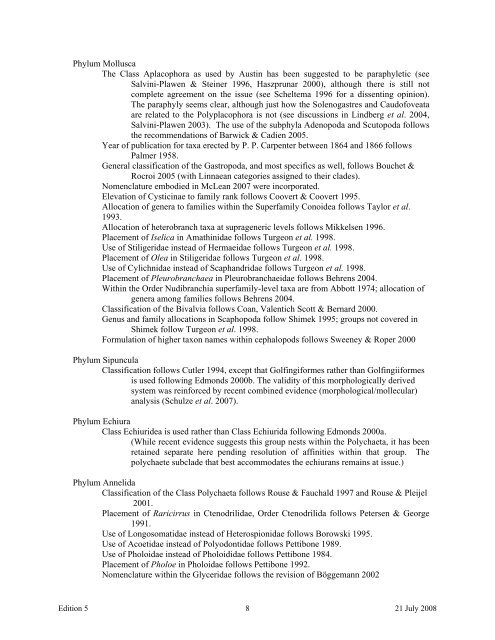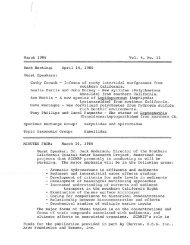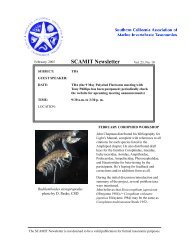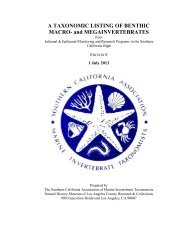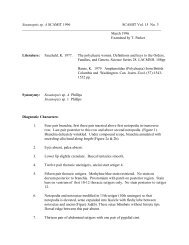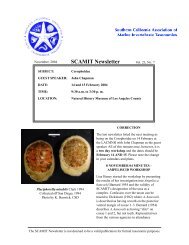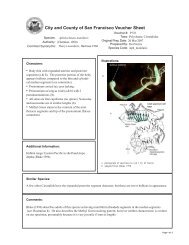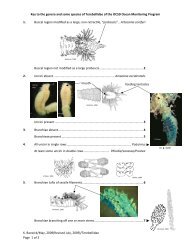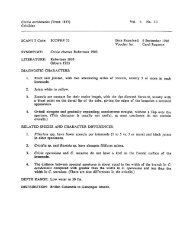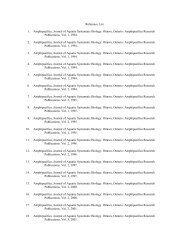Download - scamit
Download - scamit
Download - scamit
You also want an ePaper? Increase the reach of your titles
YUMPU automatically turns print PDFs into web optimized ePapers that Google loves.
Phylum Mollusca<br />
The Class Aplacophora as used by Austin has been suggested to be paraphyletic (see<br />
Salvini-Plawen & Steiner 1996, Haszprunar 2000), although there is still not<br />
complete agreement on the issue (see Scheltema 1996 for a dissenting opinion).<br />
The paraphyly seems clear, although just how the Solenogastres and Caudofoveata<br />
are related to the Polyplacophora is not (see discussions in Lindberg et al. 2004,<br />
Salvini-Plawen 2003). The use of the subphyla Adenopoda and Scutopoda follows<br />
the recommendations of Barwick & Cadien 2005.<br />
Year of publication for taxa erected by P. P. Carpenter between 1864 and 1866 follows<br />
Palmer 1958.<br />
General classification of the Gastropoda, and most specifics as well, follows Bouchet &<br />
Rocroi 2005 (with Linnaean categories assigned to their clades).<br />
Nomenclature embodied in McLean 2007 were incorporated.<br />
Elevation of Cysticinae to family rank follows Coovert & Coovert 1995.<br />
Allocation of genera to families within the Superfamily Conoidea follows Taylor et al.<br />
1993.<br />
Allocation of heterobranch taxa at suprageneric levels follows Mikkelsen 1996.<br />
Placement of Iselica in Amathinidae follows Turgeon et al. 1998.<br />
Use of Stiligeridae instead of Hermaeidae follows Turgeon et al. 1998.<br />
Placement of Olea in Stiligeridae follows Turgeon et al. 1998.<br />
Use of Cylichnidae instead of Scaphandridae follows Turgeon et al. 1998.<br />
Placement of Pleurobranchaea in Pleurobranchaeidae follows Behrens 2004.<br />
Within the Order Nudibranchia superfamily-level taxa are from Abbott 1974; allocation of<br />
genera among families follows Behrens 2004.<br />
Classification of the Bivalvia follows Coan, Valentich Scott & Bernard 2000.<br />
Genus and family allocations in Scaphopoda follow Shimek 1995; groups not covered in<br />
Shimek follow Turgeon et al. 1998.<br />
Formulation of higher taxon names within cephalopods follows Sweeney & Roper 2000<br />
Phylum Sipuncula<br />
Classification follows Cutler 1994, except that Golfingiformes rather than Golfingiiformes<br />
is used following Edmonds 2000b. The validity of this morphologically derived<br />
system was reinforced by recent combined evidence (morphological/mollecular)<br />
analysis (Schulze et al. 2007).<br />
Phylum Echiura<br />
Class Echiuridea is used rather than Class Echiurida following Edmonds 2000a.<br />
(While recent evidence suggests this group nests within the Polychaeta, it has been<br />
retained separate here pending resolution of affinities within that group. The<br />
polychaete subclade that best accommodates the echiurans remains at issue.)<br />
Phylum Annelida<br />
Classification of the Class Polychaeta follows Rouse & Fauchald 1997 and Rouse & Pleijel<br />
2001.<br />
Placement of Raricirrus in Ctenodrilidae, Order Ctenodrilida follows Petersen & George<br />
1991.<br />
Use of Longosomatidae instead of Heterospionidae follows Borowski 1995.<br />
Use of Acoetidae instead of Polyodontidae follows Pettibone 1989.<br />
Use of Pholoidae instead of Pholoididae follows Pettibone 1984.<br />
Placement of Pholoe in Pholoidae follows Pettibone 1992.<br />
Nomenclature within the Glyceridae follows the revision of Böggemann 2002<br />
Edition 5 8 21 July 2008


